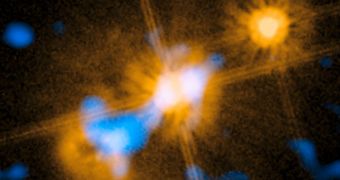Ever since astrophysicists started analyzing black holes in more details, a number of questions popped up in their heads. Chief among them was a puzzling mystery, the inability to explain why the masses of black holes and their parent galaxies were linked. A new study seeks to clarify the issue.
In fact, this question can be reduced to an even simpler one – which came first, the galaxy or its black hole? Finding out whose growth determined the other's has been a long-standing goal in astronomy, and opinions have thus far remained divided across the board.
What the new investigation is proposing is that supermassive black holes employ mechanisms that can trigger the formation of a new galaxy. What this means is that the dark behemoths simply trigger the production of new stars in their neighborhood, surrounding themselves with “food.”
This proposal also offers an elegant way of explaining why galaxies that host the largest black holes tend to have more stars than galaxies which are powered by smaller collapsed stars. The data were compiled after a prolonged study of a stellar object called a “naked quasar.”
A quasi-stellar radio source (quasar) is the core of a very distant, active galactic nucleus. However, there are such structures for which investigators have been unable to find a host galaxy. These objects are called naked quasars, meaning that they have no home.
For the new investigation, the research team focused its attention on the quasar HE0450-2958. Experts used the European Southern Observatory's (ESO) Very Large Telescope (VLT), in Chile, because the tool has an excellent mid-infrared camera called VISIR.
Many had speculated that HE0450-2958's host galaxy was not visible because it was obscured by massive amounts of dust, but the structures should have become visible in infrared wavelengths. With this research, experts demonstrated that the object is indeed a naked quasar, Daily Galaxy reports.
“Observing at these wavelengths would allow us to trace dust that might hide the host galaxy. However, we did not find any. Instead we discovered that an apparently unrelated galaxy in the quasar's immediate neighborhood is producing stars at a frantic rate,” VLT study leader Knud Jahnke explains.
The team determined that the object was producing as many as 350 Sun-like stars per year, which is a rate 100 times higher than the average galaxy in the local Universe. As such, the experts propose that the quasar is the trigger for such frantic stellar formation.
“The two objects are bound to merge in the future: the quasar is moving at a speed of only a few tens of thousands of km/h with respect to the companion galaxy and their separation is only about 22 000 light-years,” Elbaz explains.
“Although the quasar is still 'naked', it will eventually be 'dressed' when it merges with its star-rich companion. It will then finally reside inside a host galaxy like all other quasars,” he concludes.

 14 DAY TRIAL //
14 DAY TRIAL //